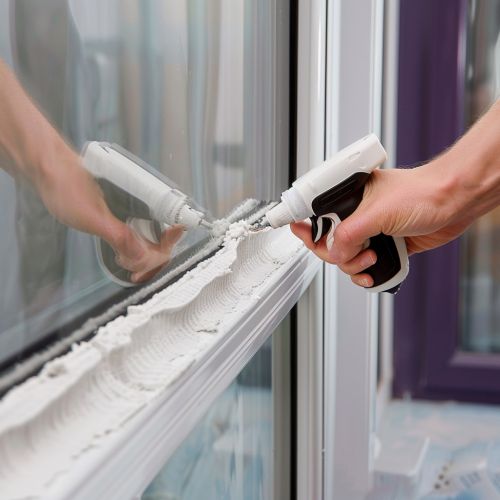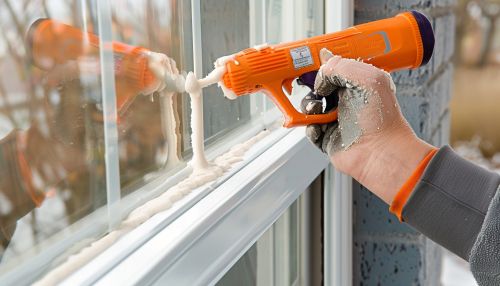Caulking
Introduction
Caulking is a critical process in construction and maintenance, involving the sealing of joints or seams in various structures and certain types of piping. The primary purpose of caulking is to prevent water, air, dust, insects, and other contaminants from entering or exiting through gaps and cracks. This article delves into the materials, techniques, history, and applications of caulking, providing a comprehensive understanding of its importance in various industries.
History of Caulking
The practice of caulking dates back to ancient times. Early examples include the use of natural materials like reeds, moss, and animal fats to seal the seams of wooden ships. The Ancient Egyptians used a form of caulking in their shipbuilding techniques, employing reeds and bitumen to waterproof their vessels. Over the centuries, the materials and methods have evolved significantly, leading to the development of modern caulking compounds and techniques.
Materials Used in Caulking
Caulking materials have diversified over time, with modern options offering enhanced durability, flexibility, and ease of application. The primary types of caulking materials include:
Silicone
Silicone caulk is highly flexible and resistant to moisture, making it ideal for areas exposed to water, such as bathrooms and kitchens. It adheres well to non-porous surfaces like glass, metal, and ceramic.
Acrylic Latex
Acrylic latex caulk is paintable and easy to clean up with water, making it a popular choice for interior applications. It is suitable for sealing gaps in wood, drywall, and masonry.
Polyurethane
Polyurethane caulk is known for its strong adhesion and flexibility. It is often used in exterior applications due to its resistance to weathering and UV radiation.
Butyl Rubber
Butyl rubber caulk is highly adhesive and flexible, making it suitable for sealing joints in roofing, gutters, and other outdoor structures. It remains pliable over a wide temperature range.
Oil-Based Caulk
Oil-based caulks are less common but are used in specific applications where other types may not be suitable. They provide good adhesion and durability but can be more challenging to work with.


Techniques of Application
Proper application of caulking is essential to ensure its effectiveness. The following steps outline the general process:
Surface Preparation
The surface must be clean, dry, and free of old caulk, dirt, and debris. This may involve scraping, sanding, and cleaning with a suitable solvent.
Cutting the Nozzle
The nozzle of the caulking tube should be cut at a 45-degree angle to match the size of the gap being sealed. A smaller opening is used for narrow gaps, while a larger opening is suitable for wider joints.
Applying the Caulk
Using a caulking gun, apply a continuous bead of caulk along the joint. Maintain steady pressure and a consistent speed to ensure an even application.
Smoothing the Bead
After application, the bead of caulk should be smoothed using a caulking tool or a finger dipped in water. This helps to ensure proper adhesion and a neat finish.
Curing
Allow the caulk to cure according to the manufacturer's instructions. This may involve keeping the area dry and undisturbed for a specified period.
Applications of Caulking
Caulking is used in a wide range of applications across various industries:
Construction
In construction, caulking is used to seal joints in buildings, including windows, doors, and siding. It helps to improve energy efficiency by preventing air leaks and enhances the building's durability by keeping out moisture.
Marine
In the marine industry, caulking is essential for sealing the seams of wooden boats and ships. Modern marine caulks are designed to withstand harsh saltwater environments and provide long-lasting protection.
Automotive
Caulking is used in the automotive industry to seal seams and joints in vehicles, preventing water and dust ingress. It is also used in the assembly of certain components to ensure a tight fit.
HVAC
In heating, ventilation, and air conditioning (HVAC) systems, caulking is used to seal ductwork and prevent air leaks. This helps to improve system efficiency and reduce energy consumption.
Plumbing
Caulking is used in plumbing to seal joints and connections, preventing leaks and ensuring the integrity of the system. It is commonly used around sinks, bathtubs, and other fixtures.
Maintenance and Repair
Regular maintenance and repair of caulking are essential to ensure its continued effectiveness. Over time, caulk can degrade, crack, or peel, necessitating replacement. The following steps outline the general process for repairing caulking:
Inspection
Regularly inspect caulked joints for signs of wear and damage. Look for cracks, gaps, and areas where the caulk has pulled away from the surface.
Removal
Remove the old caulk using a caulk removal tool or a utility knife. Be careful not to damage the surrounding surfaces.
Cleaning
Clean the joint thoroughly to remove any residue, dirt, and debris. Use a suitable solvent if necessary.
Reapplication
Apply new caulk following the same techniques outlined in the application section. Ensure proper adhesion and a neat finish.
Environmental Considerations
The environmental impact of caulking materials is an important consideration. Some caulks contain volatile organic compounds (VOCs) that can contribute to air pollution and have health implications. Manufacturers are increasingly developing low-VOC and environmentally friendly caulking options. Proper disposal of old caulk and empty tubes is also important to minimize environmental impact.
Innovations in Caulking
Recent innovations in caulking technology have led to the development of advanced materials and application methods. These include:
Hybrid Caulks
Hybrid caulks combine the best properties of different types of caulking materials, offering enhanced performance and versatility.
Advanced Application Tools
New tools and accessories, such as powered caulking guns and precision nozzles, have made the application process more efficient and user-friendly.
Smart Caulks
Research is ongoing into the development of smart caulks that can change color to indicate wear or damage, providing a visual cue for maintenance.
